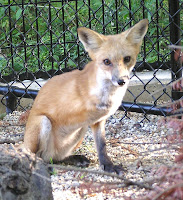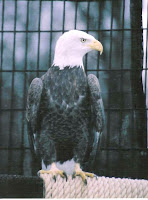-
Willowbrook's wildlife have stories to tell
(POSTED: 10/19/09) It was a Sunday morning at the Willowbrook Wildlife Center, and wildlife specialist Sandy Woltman had already seen a muskrat with a hip injury, two Cooper's hawks and 23 hurt birds. A red-tailed hawk and a painted turtle were listed on the board, waiting to get checked in next. Meanwhile, the phones were busy with callers -- one asking about a "bloodcurdling scream heard in the night" (believed to have been a screech owl) and another concerned about a skunk they found walking strangely.
"It's like an emergency room atmosphere," Woltman said, describing the animal rehabilitation and education center in Glen Ellyn. "You never know what's coming in next."
Willowbrook, located at 525 S. Park Blvd., doubles as a safe haven for critters native to DuPage County and an explorer's retreat for those curious about the wildlife in their own backyard. The center provides treatment for animals with behavioral or physical disabilities -- nearly 8,000 total in 2008 -- with the goal of releasing the creatures back into the wild. Also featuring a nature trail, butterfly garden and animal exhibits, Willowbrook welcomes people to visit and learn more about the ecosystem.
This fall the DuPage County Forest Preserve will launch the initial phase of a plan to upgrade the facility -- its first expansion in 28 years. After collecting the public's opinion through a survey, both district and Willowbrook staff will meet mid-month with an architect to weigh the visitors' suggestions along with the needs of the workers and the animals. Although the options are open, one thing is for sure -- no one will be building over the characteristic charm of the intimate facility.
"We don't want to be bigger, bigger, bigger," said Sandy Fejt, education site manager. "We want to keep the quiet, low-key environment. That's what we think people tend to enjoy more. You don't have the big crowds and commercialism here like you see in other places."
Volunteers also play an important role in personalizing the experience for people. While Mike Shimer, 58, was teaching a few visitors about snakes, the milk snake he was handling wound itself around his waist -- through all of his belt loops -- and into his right pocket. In the pet corner, 17-year-old Adam Guenther, who wants to be a veterinarian at a wildlife or exotic zoo, held Mocha the dove for a 9-year-old girl, who also wants to be a vet someday. It's this kind of interaction, Shimer says, that brings back a lot of regulars.
During a recent trip to Willowbrook, ChicagoWildlifeNews spent some time with Woltman to learn more about the animals permanently housed in the outdoor exhibit. Woltman, who oversees animal care and has been working at the center since 1991, said that these animals are kept because they would not survive if sent back into the wild. Since there are about 100 creatures on permanent display, these are just a few stories of some of the animals that have been rescued and rehabilitated, and that now call Willowbrook home.
Red Foxes
You might catch one of the female red foxes slowly walking around in circles, as if trying to follow her own tail. She's not depressed, nor is she forming a bed to lie down. This fox suffers from a neurological disorder, which affects her motor skills.
"She's a little off," Woltman said. "It affects the brain, so she has a head tilt and sometimes she'll tumble a bit. . . . Typically, it's a long-term problem. She showed so much improvement and then just plateaued."
The fox, who is also deaf, was transferred from a Michigan facility in August 2008 and was originally found in a farm field.
The second female fox lives with only three legs, and even though she has adapted well, she likely would not be able to survive on her own. The fox was found on a back porch of a Lombard home in 2003 and chased into the Lombard Common park before the police caught her. After they took her to Willowbrook, she was diagnosed with a broken leg and a mange. Woltman says they had to amputate the fox's leg because it was so severely broken. "It came down to either euthanize her or amputate the leg," she said. "She lost that leg when she was young, but she did great adapting."
Raccoons
In March of 1994, some Bolingbrook residents found two raccoons in their attic and began raising them as pets. But after a couple of months, the people didn't want the animals anymore because of their destructive behavior. The raccoons were brought to Willowbrook that June, and animal care discovered that they were too tame to ever be released.
"We tried to reverse it, but they were just too tame," Woltman said.
Willowbrook workers applied negative reinforcement, which included spraying the raccoons with a hose or zapping them with a cattle prod, to get them afraid of people again. (Although it sounds cruel, Woltman said this method was necessary, given the situation, and it has proven to work in the past.) They also tried removing all human contact and banging on their cages to scare them, but the raccoons were unfazed.
Bald Eagle
Willowbrook's bald eagle broke its wing after it was shot in Baltimore in 1995, and although the wing healed, the bird hasn't been able to fly well.
"He has poor circulation in his flight feathers," Woltman said. "They grow in and then they all fall out. Basically it's follicle damage."
The bird is the first permanent bald eagle on display, although not the first to come through the center's doors.
Bobcat
The bobcat was hit by a car in southern Illinois in December of 2005, and its eyesight has been permanently damaged as a result of the head trauma.
The male cat came to Willowbrook two years after the accident, and he is the first bobcat that Woltman has seen at the facility. Though rare, Woltman says that there are some bobcats in the southern part of DuPage County.
Barn Owls
The male barn owl was raised in captivity in Kansas and came to Willowbrook in 1994 too habituated to ever be set free. The female was hit by a car and brought to the wildlife center in 2005, transferring from Oregon.
Since barn owls are common on the West Coast, Woltman says the sick or injured birds are often euthanized. "A lot of them are put to sleep because you just can't find homes for them," she said.
As in the case of the owls, the animals at Willowbrook can come from anywhere in the country, depending on the needs of the facility.
"We're looking for an ambassador for the species to be on display to educate the people about the species," Woltman said.
By Katie Drews, for ChicagoWildlifeNews
Contact: [email protected]
Photos courtesy of Willowbrook

0 comments: